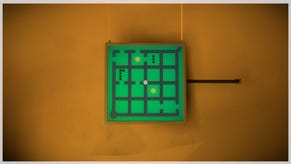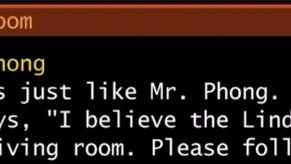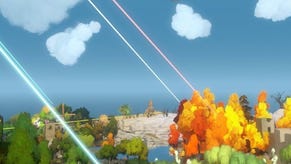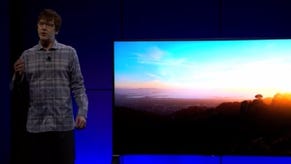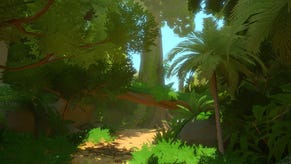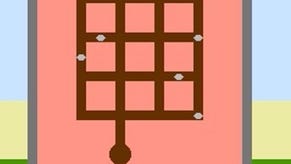Jonathan Blow
"In this game there are hardly any verbs…"
This is really interesting. What your character is doing in this game is almost exactly the same thing as you're doing as a player. The only difference is that your character is ostensibly in this world and you're on the other side of the screen. You're basically doing the same thing. And then the fiction that's layered through the story of the game, the things the narrator is talking to you about, works on a different level.
One is a very minute-to-minute level, and it's addressing the overall mystery of what's going on in this place, very small bit by very small bit, because this is a ten hour game, and the dawning of understanding is meant to be paced out throughout the whole game. It's also providing a bit of variety in that minute-by-minute stuff: I'm doing a puzzle, now I'm following a cable from one puzzle to the next, now I'm exploring the island, now I'm listening to this voice telling me all these things. It's providing a good pacing of variety. If you do 100 puzzle panels in a row, it can get quite grindy.
That's the bottom level. The middle level is where the story tends to go in individual threads which are spun through individual areas. In the one of the areas, for example, the puzzle theme is about symmetry, and the story is about looking into a mirror - symmetry again - and worrying about facial symmetry and issues of the body. That's all tied together, but that story also serves a point in terms of the larger narrative.
Then there's the highest level, which just gives you some type of dawning understanding that proceeds until you get to the end of the game. At the beginning you know very little, at the end you know a lot more, but this isn't one of those games where every question will be answered at the end in a monologue. [Laughs.] And a consequence of the way the game works is that the story is inherently non-linear. The story has to be engineered so that you can listen to these threads in any order and it should still make sense.
"A lot of my feelings about this are kind of non-verbal: I just kind of do things in a certain way."
I never thought about it in that term, of being writeable, but it's something I'm definitely interested in. The game itself is about providing a lot of player freedom: it's not about going here, and turning at a certain point so that you see a certain thing. Within that context, it only really made sense to give the player freedom within the narrative as well.
What does that mean exactly? Well, there are a number of things that it could mean. A lot of my feelings about this are kind of non-verbal: I just kind of do things in a certain way. What I will say is I think there's a certain amount of room there in terms of player agency, and in terms of the player deciding what they think about a certain element of the game and the story. There are moments that are referred to but not openly discussed, for example, so there's a lot of freedom for the player to decide what that moment really was. This stuff is hard to talk about, really.
Right now, what the game looks like emerged as a sort of organic process where we weren't trying that hard to make the landscape. It was more about: I'm designing these puzzles and they need to go somewhere in the world, so what seems like a good place? The editor for the game is really amenable to big changes, so at the moment, as a result of that, we haven't worked that hard on the terrain yet. So what's in there right now is a few hills, a few things to make the game interesting, but we still don't have what we want in terms of minute-to-minute visual interest.
That kind of thing is actually part of the phase of development we're going into now. We basically know which puzzles are going to be in the game - we want to improve them, of course - but now we want to focus on the terrain more. Now let's think about the topography. We've actually started working with a bunch of architects.
There's a landscape architecture firm, and then a building structural architecture firm that we've been working with for about a month. Nothing they've been doing is in the game yet because there's a lot of basic figuring out that's going on, but once that happens, all the stuff that you can see in the game at the moment - a building's just a box with a window cut in it - that will be a real building designed by a real architect, with an interesting form. And there's the same deal with the landscape.


